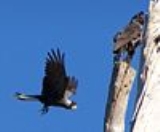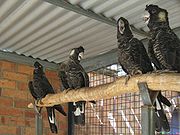
Short-billed Black-Cockatoo
Encyclopedia
The Short-billed Black Cockatoo or Carnaby's Black Cockatoo Calyptorhynchus latirostris is a cockatoo endemic to south-western Australia
. Also known as the Large Black Cockatoo, or simply Carnaby's Cockatoo, it is black with white tail feathers and white cheek patches. The adult male has a pink-red ring around the eye, and off-white cheek patches, while the female has a dark eye-ring and bright white cheek patches.
Carnaby's Black-Cockatoo is recognised as Endangered under the federal Environment Protection and Conservation Act 1999, and as Schedule 1 "fauna that is rare or is likely to become extinct" by Western Australia's Wildlife Conservation (Specially Protected
Fauna) Notice 2008(2) under the Wildlife Conservation Act 1950
. The population size of Carnaby's Cockatoo has fallen by more than 50% over the last 45 years, and up to a third of their traditional breeding grounds in the Wheatbelt area of WA have been abandoned.
Adult males have a dark grey beak and pink eye-rings. The adult female has a bone coloured beak, grey eye-rings, and its ear patches are paler than that of the male. Juveniles have a bone coloured beak, grey eye-rings, and have less white in the tail feathers.
 Carnaby's Cockatoo feeds primarily on seeds of proteaceous plants such as Banksia, Hakea and Grevillea, and secondarily on seeds from myrtaceous plants such as Eucalyptus and Corymbia. Over fifty native plant species are commonly used for food, either as seed or flowers, and this includes Sheoak (Allocasuarina fraseriana), Orange Wattle (Acacia saligna), and grasstrees (Xanthorrhoea preissii). Invertebrates such as the larvae of wood-boring moths are also eaten. The Cockatoos have also been observed feeding on seeds of Pinus spp. in the Gnangara pine plantations north of Perth.
Carnaby's Cockatoo feeds primarily on seeds of proteaceous plants such as Banksia, Hakea and Grevillea, and secondarily on seeds from myrtaceous plants such as Eucalyptus and Corymbia. Over fifty native plant species are commonly used for food, either as seed or flowers, and this includes Sheoak (Allocasuarina fraseriana), Orange Wattle (Acacia saligna), and grasstrees (Xanthorrhoea preissii). Invertebrates such as the larvae of wood-boring moths are also eaten. The Cockatoos have also been observed feeding on seeds of Pinus spp. in the Gnangara pine plantations north of Perth.
Typically, birds sit in the crowns of trees cracking the seed pods or cones, but occasionally they forage for fallen seed on the ground.
Australia
Australia , officially the Commonwealth of Australia, is a country in the Southern Hemisphere comprising the mainland of the Australian continent, the island of Tasmania, and numerous smaller islands in the Indian and Pacific Oceans. It is the world's sixth-largest country by total area...
. Also known as the Large Black Cockatoo, or simply Carnaby's Cockatoo, it is black with white tail feathers and white cheek patches. The adult male has a pink-red ring around the eye, and off-white cheek patches, while the female has a dark eye-ring and bright white cheek patches.
Carnaby's Black-Cockatoo is recognised as Endangered under the federal Environment Protection and Conservation Act 1999, and as Schedule 1 "fauna that is rare or is likely to become extinct" by Western Australia's Wildlife Conservation (Specially Protected
Fauna) Notice 2008(2) under the Wildlife Conservation Act 1950
Wildlife Conservation Act 1950
The Wildlife Conservation Act 1950 is an act of the Western Australian Parliament that provides the statute relating to conservation and legal protection of flora and fauna....
. The population size of Carnaby's Cockatoo has fallen by more than 50% over the last 45 years, and up to a third of their traditional breeding grounds in the Wheatbelt area of WA have been abandoned.
Description
The Short-billed Black Cockatoo is about 55 cm (21.5 in) long. It is mostly dark-grey with narrow vague light-grey scalloping, which is produced by narrow pale-grey margins at the tip of dark-grey feathers. It has a crest of short feathers on its head, and it has whitish patches of feathers that cover its ears. Its lateral tail feathers are white with black tips, and the central tail feathers are all black. The irises are dark brown and the legs are brown-grey. Its beak is shorter and broader than that of the Long-billed Black Cockatoo.Adult males have a dark grey beak and pink eye-rings. The adult female has a bone coloured beak, grey eye-rings, and its ear patches are paler than that of the male. Juveniles have a bone coloured beak, grey eye-rings, and have less white in the tail feathers.
Food and foraging

Typically, birds sit in the crowns of trees cracking the seed pods or cones, but occasionally they forage for fallen seed on the ground.

